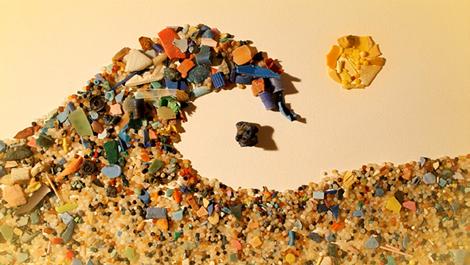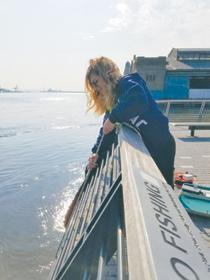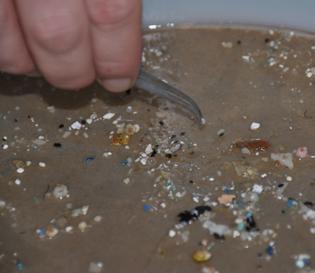
5 minute read
Micro-plastics: Where Are They Coming From?
Symbol Alone
Logo with stacked type
Advertisement
Micro-plastics: Where are They Coming From?
By Gary Brown, President, RT Environmental Services
Type Alone
Micro-plastics are receiving increased attention, particularly since the passage of the Micro-Bead Free Waters Act of 2015. Micro-plastics are tiny pieces of plastics less than one-quarter of an inch in size that start out in different forms. Some micro-plastics start out as microbeads in our personal care products, but others were previously microfibers in textiles, scrubbers used for industrial clothing, or they are plastic raw material broken down into smaller pieces. Micro-plastics concerns include: • Plastic degrades slowly • They can release contaminants into water • Contaminants in polluted water can attach to micro-plastics • Some of them look like fish food and fish ingest them Studies are under way throughout the world and there is increasing evidence of fish consumption of micro-plastics, and there is rising concern that eating fish may be bad from a consumption standpoint for humans. There are few studies that define what happens from the contamination standpoint, about the significance or impacts from chemical contaminants in micro-plastics moving up the food chain. Scientists say the oceans’ fish are becoming smaller because of the damaging effects of plastics in the water. Exposure to high concentrations of micro-plastics has been found to stunt growth and alter the feeding habits of fish by causing them to ignore their natural zooplankton food source. Consumption of micro-plastics has also caused fewer hatchlings and slow response to predators, causing the fish population to decrease. It has been estimated that by 2050 there will be more plastic in the oceans than fish. The Micro-Bead Free Waters Act went quickly through Congress at the time of passage, but there are serious questions about whether it covers all actual sources of micro-plastics which get into our waterways. From an ecological standpoint, micro-plastics are not believed to be a threat to our water supplies as water supply technology usually provides filtration. But on the wastewater side, it is generally agreed that micro-plastics pass through domestic wastewater treatment plants. There are calls to determine the volume of micro-plastics in the Chesapeake Bay, and how they may be impacting health. The Chesapeake Bay is frequently viewed as a key estuary to study
Pollutants like micro-plastics “bioaccumulate,” or increase in quantity, as they move up the food chain. This happens when small fish ingest contaminants, large fish consume small fish, and then people catch and eat them. The longer a fish lives, the more time it has to bioaccumulate pollution.
contaminants, due to its size and slow water turnover. Micro-beads have received much recent attention because they are known to be a deliberate additive to facial products used for skin cleansing. During the use process, the beads break down, but there is research that suggests that micro-beads made of natural polyesters called PHAs (polyhydroxyalkanoates) can be considered biodegradable. PHAs are more dense than the plastics that occur in micro-beads, so they sink in water. Plastics and current micro-beads are buoyant, increasing the chance of them floating through sewage systems and into estuaries and marine ecosystems. Environmental groups are expressing concern that exfoliating scrubs and toothpaste with sparkles might be harming our ocean. Micro-plastics also come from larger plastic debris, such as plastic bottles and bags that have broken down into smaller particles. This source is considered a more difficult problem to address because of the ubiquitous nature of what is partially degraded litter present in waterways. Rain events have been observed to correlate with sharp increases in the number of plastic bottles, plastic bags and large plastic objects floating in water. Although litter traps can be somewhat effective, the discharge of larger plastics into water still leaves a significant large plastic source, which can break down over time. Studies in Australia’s Sydney Harbour show that while the first two sources are well understood, the third source of micro-plastics is a mystery. However, more recent scientific studies strongly suggest that the remaining large source of plastic fibers is indeed clothing. The key to fibers in clothes is knowing the details of what is involved. Polyester and acrylic fabrics are used for all sorts of clothing, from dresses to gym wear. They could be leaching upward of 700,000 tiny plastic fibers into the environment for each 15-pound load of laundry washed. This information comes from new research from Plymouth University. Different materials shed different amounts of fibers, with acrylic sweaters shedding 729,000 fibers per wash, polyesters shedding 469,000 fibers per wash, and polyester/cotton blends shedding about 138,000 fibers per wash. The type of detergent or softener used in the wash did have an effect on the amount of fibers shed, but there was no clear trend on increasing or decreasing quantities that could be correlated to the material type. It can therefore be concluded that the ubiquitous wearing and laundering of clothing is a relatively unknown but major source of micro-plastics and the hardest to control. While the full effects of plastic pollution are still being studied, there is concern that the chemicals in the plastics could kill fish before they reach reproductive age. It’s also known that plastic bits build up in sperm whales for instance and contribute to their deaths. Studies have shown that 28% of the fish in Indonesia and 25% of the fish in the United States contain plastic debris. There is concern that if no action is taken, the quantity of micro-plastics in the environment will increase in the coming years. Dr. Marcus Eriksen is a seasoned scientist who estimates that 269,000 tons of plastic from 2.25 trillion particles is present in the world’s oceans. He has a Ph.D.

Elaine Panuccio of the Delaware River Basin Commission (DRBC) collects a water sample at Race Street Pier in Philadelphia on November 16. This was DRBC’s firstever sample for micro-plastics. It plans to improve this process before partnering on a project next summer.
Type AloneCredit: Sea Education Association/Marilou Maglione A scientist with the Sea Education Association picks through micro-plastic from the North Atlantic Ocean aboard the SSV Corwith Cramer in 2010.
continued on page 15








